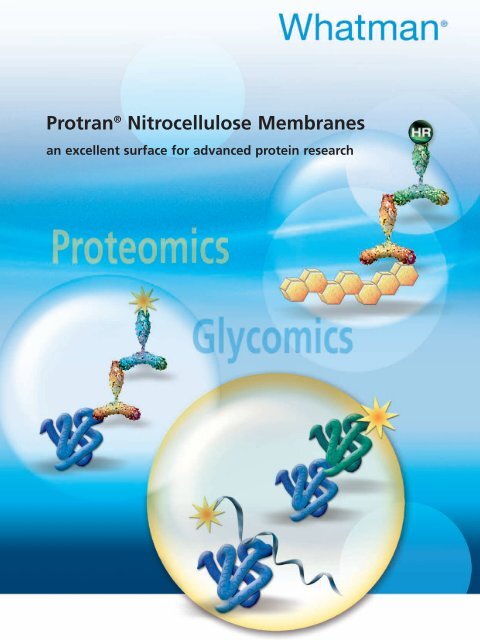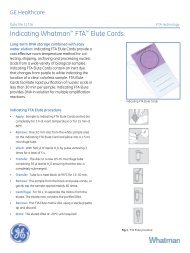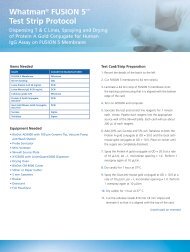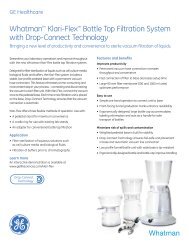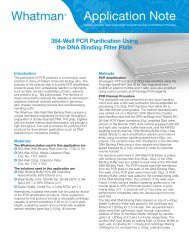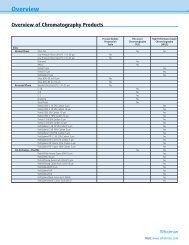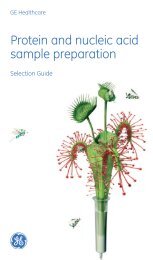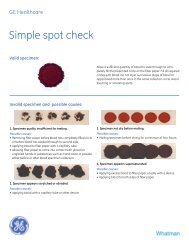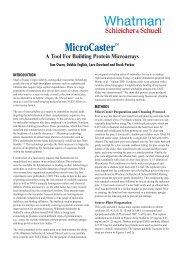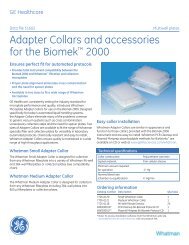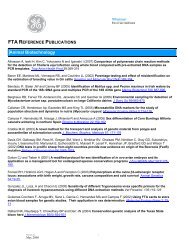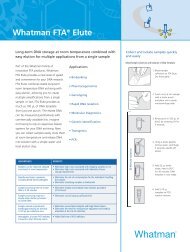Protran® Nitrocellulose Membranes - Whatman
Protran® Nitrocellulose Membranes - Whatman
Protran® Nitrocellulose Membranes - Whatman
You also want an ePaper? Increase the reach of your titles
YUMPU automatically turns print PDFs into web optimized ePapers that Google loves.
Protran ® <strong>Nitrocellulose</strong> <strong>Membranes</strong><br />
an excellent surface for advanced protein research
Protran ® is the most frequently<br />
specified blotting membrane<br />
in the world<br />
Protran nitrocellulose membranes are the most frequently specified<br />
transfer media in the world for Western, Southern and Northern<br />
blots. All blotting methods have been developed using nitrocellulose<br />
membranes and this type of membrane has set the standards.<br />
<strong>Nitrocellulose</strong> is produced by partial nitration of the natural biopolymer<br />
cellulose (Fig. 1). Nitration is an essential prerequisite for production<br />
of a microporous membrane that shows all properties of an<br />
excellent blotting membrane<br />
Protran nitrocellulose from <strong>Whatman</strong> is produced from carefully<br />
selected and validated raw materials using 100% pure nitrocellulose<br />
to ensure highest binding capacity and performance in biomolecule<br />
detection.<br />
Protran ® shows a superior<br />
mechanical strength<br />
Production parameters and the use of proper raw material<br />
strongly influence the mechanical properties of a nitrocellulose<br />
membrane.<br />
Mechanical stability of a nitrocellulose membrane is of great<br />
importance for its performance in the hand of researchers and<br />
can be quantified by tensile strength. In this test a defined<br />
membrane strip is subjected to a tension of increasing strength.<br />
Fig 1: Structure of nitrocellulose<br />
(a) Cellulose, (b) After nitration; Degree of substitution of hydroxyl groups ranges<br />
from 1.9 to 2.4.<br />
An investigation of nitrocellulose membranes from<br />
all leading manufactures clearly shows that Protran<br />
has the highest mechanical stability (i. e., tensile<br />
strength) of all nitrocellulose membranes (Fig. 2).<br />
In addition, the mechanical strength of Protran is<br />
reproducible from lot to lot. This makes Protran<br />
nitrocellulose dependable for a wide range of<br />
applications.<br />
Fig. 2: Mechanical strength of nitrocellulose membranes<br />
<strong>Nitrocellulose</strong> membranes, 0.45 µm pore size, from different manufactures/suppliers<br />
were cut into pieces of 15 x 100 mm. Tensile strength was measured (according to<br />
DIN 53 112, part 1) in an automatic tension and pressure recording apparatus.<br />
Data indicated are the mean of at least 4 independent measurements.<br />
Membrane thickness: A = 130 µm, B = 130 µm, C = 160 µm,<br />
D (mixed ester) = 160 µm and Protran BA85 = 125 µm.
In the post-genomic era protein studies have become increasingly<br />
more and more important.<br />
Protran nitrocellulose is a universal blotting surface for biomolecules<br />
like nucleic acids and proteins. However, especially for<br />
protein applications Protran nitrocellulose has unique properties<br />
which make it the best membrane for research.<br />
Protran ® affords protein stability<br />
for years<br />
A significant advantage of the proprietary Protran nitrocellulose<br />
formula is the proven excellent shelf life of proteins applied onto<br />
the membrane. Empirical evidence shows that proteins maintain<br />
molecular recognition activity for 5 years on Protran (Fig. 3),<br />
which makes it the industry standard for protein blotting.<br />
Protran is a small pore size membrane which has been used to<br />
produce millions of blots. <strong>Whatman</strong> also offers a variety of additional<br />
large pore size nitrocellulose membranes that have been<br />
used with confidence by diagnostic device manufactures for over<br />
20 years.<br />
For example in Point of Care tests like commercial pregnancy test<br />
systems a long protein shelf life is an essential prerequisite. For<br />
researchers it is an opportunity to improve the shelf life of their<br />
blots. Both, for large scale proteomics projects, as well as commercial<br />
product development, long-term stability of proteins on<br />
Protran nitrocellulose is a unique benefit.<br />
Stripes<br />
produced in:<br />
tested in: Onconeural antigens<br />
+ – + – + – + – + – + – + – + – + – + –<br />
– Amphiphysin*<br />
– Purkinje/Yo 52*<br />
– Ri*<br />
– HuD*<br />
– Control line<br />
anti human LgG<br />
Fig. 3: Stability test of onconeural autoantigens immobilized on nitrocellulose<br />
<strong>Protran®</strong> BA83<br />
Time course was 5 years (1998 to 2002).<br />
Antigens were printed in 20 mM Tris-HCl, 160 mM glycin pH 8.6. Membrane strips were dried, sealed<br />
in a plastic pouche with a dessicant pad and stored dark at 2-8 °C. For detection membrane strips were<br />
blocked, incubated with human sera and washed. Patient antibodies bound to the antigens were visualized<br />
using anti-human IgG antibody conjugated to alkaline phosphatase and p-nitrophenyl phosphate as<br />
substrate (“ONA Blot”). The four strips shown in each box respectively originate from the same batch.<br />
+ indicates the result with a mixture of sera reacting with all four onconeural antigens<br />
– indicates the result with a negative serum<br />
* Amphiphysin, Yo 52, Ri, HuD are nuclear proteins present in nerve cells. They can give rise to auto<br />
immune diseases with paraneoplastic symptoms.<br />
They can be associated with various cancer types (lung, ovary, breast)<br />
(Data are kindly provided by Prof. Seelig and colleagues, Karlsruhe, Germany, www.laborseelig.de)
Protran ® is excellent for<br />
carbohydrate studies<br />
Protran nitrocellulose is not only an excellent surface for wellestablished<br />
Western blotting applications. After the advent of<br />
genomic and proteomic studies other fields of research are also<br />
moving into the focus of interest.<br />
The latest “-omics” suffix describes the study of carbohydrates,<br />
called glycomics. Since the decoding of the human genome has<br />
revealed no more than 50 000 encoded proteins the importance<br />
of post-translational modifications for a precise adjustment of<br />
metabolism has been emphasised. Well-known modifications of<br />
proteins like glycosylation help proteins to get a proper threedimensional<br />
structure or address them to the right location in<br />
the cell.<br />
Recently more and more information is accumulating about<br />
proteins that act through oligosaccharide recognition.<br />
One approach for discovering new carbohydrate-recognizing<br />
proteins in the proteome, and for mapping carbohydrate<br />
recognition structures in the glycome, are arrays of oligosaccharides<br />
[1]. Fig. 4 shows the highly sensitive detection<br />
of carbohydrates on Protran nitrocellulose membranes.<br />
A quantitative immunostaining experiment clearly indicates<br />
a more than 10-fold higher signal intensity for oligosaccharides<br />
(as NGLs*) on Protran nitrocellulose.<br />
Protran ® offers highest sensitivity<br />
for protein-protein interaction<br />
studies<br />
A key role in fine tuning of metabolism is taken by regulatory proteins that act<br />
through the recognition of nucleotide or amino acid sequences. Using fluorescence<br />
labelled probes and protein samples spotted on Protran enables analysis<br />
of signals from protein-protein (Fig. 5) or protein-DNA interactions (Fig. 6)<br />
with high sensitivity of detection.<br />
a. CRP E. coli b. Binding to Cy5.5 α RNP E. coli<br />
Fig. 4: Immuno detection of oligosaccharides immobilized as<br />
NGLs on <strong>Protran®</strong> BA85<br />
Oligosaccharide NGLs* of acidic 16mer from chondroitin sulfate C (CSC 16mer)<br />
were printed in chloroform/methanol/water (25:25:8 vol/vol/vol). For the amounts<br />
indicated 2 mm slots were applied onto Protran BA85 nitrocellulose and polyvinylidene<br />
fluoride (PVDF) membranes with a sample applicator. For detection<br />
membranes were blocked, incubated with anti-CS (CS-56, mAb) and washed.<br />
Antibody binding was visualized using anti-rabbit IgG antibody conjugated to<br />
horseradish peroxidase and 3´-diaminobenzidine reagent as substrate (“DAB-<br />
FAST”). * Neoglycolipids (NGLs) can be prepared by reductive amination of the<br />
reducing oligosaccharide with an amino lipid. The NGL technology generates<br />
lipid-linked oligosaccharide probes from glycoproteins and polysaccharides which<br />
are particularly suitable for the arraying of oligosaccharides.<br />
(Data are kindly provided by Professor Ten Feizi, Imperial College London,<br />
Northwick Park & St Mark’s Hospital Campus Harrow, Middlesex, UK.<br />
The method is described in [1].)<br />
Fig. 5: SDS PAGE analysis and fluorescence detection of protein<br />
protein interactions on <strong>Protran®</strong> BA83<br />
(a) Total protein (crude extracts) of noninduced and 30, 60 and 120 min IPTG<br />
induced samples of E. coli CRP (cAMP receptor protein) and purified His-tagged<br />
CRP were analysed by polyacrylamide gel-electrophoresis. (b) For the amounts<br />
indicated CRP arrays were prepared with the same crude extracts or purified<br />
protein. Total protein amount is shown in pg, the amount of purified CRP is<br />
shown in fmol and amol. Extracts were spotted on a Protran BA83 nitrocellulose<br />
membrane. Binding reactions were carried out in the presence of 5 mM cAMP<br />
with a Cy5.5 labelled E. coli RNA polymerase a subunit. Protein-protein binding<br />
was detected after incubation in PBS solution and with corresponding Cy5.5<br />
labelled protein with The Odyssey Infrared Imaging system (LI-COR).<br />
(Data see under Fig. 6)
a. ArgR B. stearothermophilus<br />
Binding to IRD-800<br />
b. 76 bp DNA c. 56 bp DNA<br />
Fig. 6: SDS PAGE analysis and fluorescence detection of protein-DNA interactions on <strong>Protran®</strong> BA83<br />
In a protein-protein binding assay E. coli cyclic adenosine monoposphate<br />
receptor protein (CRP) was printed on Protran nitrocellulose<br />
and incubated with Cy5.5 labelled E. coli RNA polymerase<br />
α subunit (α RNP). It was possible to detect a signal from a purified<br />
E. coli CRP spot with 150 amol protein (Fig. 5b).<br />
In a protein-DNA binding assay up to 12 amol of a spotted<br />
protein could be detected using IRD-800 labelled DNA probes.<br />
Serial purified Arginine repressor (ArgR) protein were spotted on<br />
Protran nitrocellulose and incubated with two different shortened<br />
derivates of a PargCo promoter-operator region (Fig. 6 b, c).<br />
linear relationship of fluorescent response was measurable over<br />
more than 2 orders of magnitude (between 3.3 fmol and 12.9<br />
amol of purified ArgR protein). Even the higher affinity of the<br />
tested repressor protein to a double Arg box-carrying DNA probe<br />
(Fig. 6 b) compared to single Arg box-carrying probe<br />
(Fig. 6 c) was detectable.<br />
The data shown document the outstanding features of Protran<br />
nitrocellulose membranes in molecular research. The advantage<br />
of biomolecules immobilised on nitrocellulose is obvious.<br />
Non-covalent immobilisation on nitrocellulose avoids the modi<br />
fication of biomolecules like in approaches with covalent binding<br />
on chemically activated surfaces and preserves molecular recognition<br />
activity. Altogether the mechanical strength of Protran as<br />
well as long-term stability and accessibility of proteins for binding<br />
reactions are of great importance for a stable and sensitive assay<br />
and reliable results.<br />
“Concerning the choice of NC brand we have found Schleicher<br />
& Schuell’s* to be the best (highest binding capacity, highest<br />
signal:background ratio)...” [3]. – *[now <strong>Whatman</strong>]<br />
What was true when the first blot on nitrocellulose was carried<br />
out is still highy accurate and important today.<br />
(a) Total protein (crude extracts) of noninduced and 30, 60 and 120 min IPTG induced samples of B. stearothermophilus ArgR (arginine repressor) and purified His-tagged ArgR were analysed<br />
by polyacrylamide gel-electrophoresis. (b, c) For the amount indicated ArgR arrays were prepared with the same crude extracts or purified protein. Total protein amount is shown in pg, the<br />
amount of purified ArgR is shown in fmol and amol. Extracts were spotted on a Protran BA83 nitrocellulose membrane. Binding reactions were carried out with a 76 bp IRD-800 labelled DNA<br />
probe of the entire B. stearothermophilus PargCo region (containing a double Arg-box carrying operator) or with a 56 bp IRD-800 labelled DNA probe of a shortened PargCo region (containing<br />
a single Arg-box carrying operator). DNA-protein binding was detected after incubation in DNA-binding buffer and IRDye 800-labelled DNA probe with the Odysses Infrared Imaging system<br />
(LI-COR).<br />
Fig. 5 and 6: (Data are kindly provided by Professor Vehary Sakanyan, ProtNeteomix & Nantes University, Nantes, France, www.protneteomix.com. The method is described in [2].)
SPECIFICATIONS<br />
Protran ® 100 % pure nitrocellulose<br />
APPLICATIONS<br />
BINDING CAPACITY<br />
Western,<br />
Southern,<br />
Northern blotting...<br />
* pore size: 0.45 µm 80 µg/cm2 * pore size: 0.2 µm 90 µg/cm2 * pore size: 0.1 µm 110 µg/cm2 TRANSFER METHODS:<br />
Semi-dry blotting ++<br />
Tank blotting ++<br />
Vacuum blotting ++<br />
Capillary blotting ++<br />
Alkaline method<br />
IMMOBILIZATION:<br />
not recommended<br />
Drying Proteins<br />
UV-crosslinking DNA/RNA<br />
Baking (80°C)<br />
DETECTION METHODS:<br />
DNA/RNA<br />
Colorimetric ++<br />
** Chemiluminescent ++<br />
Isotopic ++<br />
Fluorescent ++<br />
ORDERING INFORMATION<br />
FURTHER INFORMATION<br />
* Protran membranes are available in<br />
a range of pore sizes for optimal performance<br />
in a variety of applications.<br />
0.45 µm pore size Protran BA85 is<br />
the general lab standard for most<br />
protein and nucleic acid applications.<br />
The 0.2 µm pore size of Protran BA83<br />
ensures high retention of small<br />
samples below 20 kD. BA79 is the<br />
membrane of choice for smaller<br />
molecules below 7 kD.<br />
** Protran <strong>Nitrocellulose</strong> <strong>Membranes</strong><br />
are compatible to a variety of detection<br />
methods. In case of chemiluminescent<br />
detection we recommend horseradish<br />
peroxidase based systems.<br />
Description Pore Size (µm) Size (mm) Qty / Pkg Item #<br />
Protran BA85, circles 0.45 µm ø 82 50 10401116<br />
" 0.45 µm ø 132 25 10401124<br />
Protran BA85, sheets 0.45 µm 200 x 200 5 10402680<br />
" 0.45 µm 200 x 200 25 10401191<br />
" 0.45 µm 300 x 600 5 10401180<br />
Protran BA85, roll 0.45 µm 200 x 3 m 1 10401197<br />
" 0.45 µm 300 x 3 m 1 10401196<br />
Protran BA83, circles 0.2 µm ø 82 50 10401316<br />
Protran BA83, sheets 0.2 µm 200 x 200 5 10402452<br />
" 0.2 µm 200 x 200 25 10401391<br />
" 0.2 µm 300 x 600 5 10401380<br />
Protran BA83, roll 0.2 µm 200 x 3 m 1 10402495<br />
" 0.2 µm 300 x 3 m 1 10401396<br />
Protran BA79, sheets 0.1 µm 200 x 200 5 10402062<br />
" 0.1 µm 200 x 200 25 10402091<br />
" 0.1 µm 300 x 600 5 10402080<br />
Protran BA79, roll 0.1 µm 300 x 3 m 1 10402096<br />
Accessory Products Thickness Size (mm) Qty / Pkg Item #<br />
Blotting Paper 3MM, sheets 0.34 mm 200 x 200 100 3030-801<br />
" 0.34 mm 460 x 570 100 3030-917<br />
Blotting Paper 17 Chr, sheets 0.92 mm 460 x 570 25 3017-915<br />
Blottingpaper GB004, sheets 1.00 mm 460 x 570 100 10427926<br />
Blottingpaper GB005, sheets 1.50 mm 580 x 580 25 10426994<br />
REFERENCES<br />
[1] Fukui S., Feizi T., Galustian C., Lawson A. M. and W. Chai. Oligosaccharide microarrays for high-throughput detection and specificity assignments of<br />
carbohydrate-protein interactions. Nature Biotechnology 2002, Vol. 20, 1011-1017<br />
[2] Snapyan M., Lecocq M., Guével L., Arnaud M.-C., Ghochikyan A., and V. Sakanyan. Dissecting DNA-protein and protein-protein interactions involved in<br />
bacterial transcriptional regulation by a sensitive protein array method combining a near-infrared fluorescence detection. Proteomics 2003, 3, 647-657.<br />
[3] Bjerrum O. J. and N. H. H. Heegaard (eds.). CRC Handbook of Immunoblotting of Proteins. CRC Press, Boca Raton, Florida, Vol. 1, 105.<br />
<strong>Whatman</strong> Inc. · 200 Park Avenue · Florham Park, NJ 07932 · USA · Tel 1-800-631-7290 · Fax 973-773-0168 · www.whatman.com · info@whatman.com<br />
Schleicher & Schuell BioScience GmbH · <strong>Whatman</strong> Group · Hahnestrasse 3 D-37586 Dassel, Germany · Tel +49-5561-791-463 · Fax +49-5561-791-583<br />
www.whatman.com · www.schleicher-schuell.de/bioscience · techbio@schleicher-schuell.de<br />
Find out more about the<br />
best platform for protein<br />
microarrays:<br />
www.arraying.com<br />
Other formats are<br />
available upon request!<br />
<strong>Whatman</strong> offers the complete<br />
range of blotting membranes!<br />
Optitran ® , reinforced nitrocellulose<br />
membrane, Nytran ® nylon and<br />
Westran ® PVDF membranes are<br />
high performance membranes for<br />
nucleic acid and protein research.<br />
TOPAS-BS<br />
E2/06/05


